INTRODUCTION
In these times, practicing efficiently is critical. We need the tools necessary to help create beautiful posterior composites quickly, resulting in minimal chair time and less strain on the body. As composites become a larger part of our revenue stream, we focus on better adhesives, curing lights, matrix systems, isolation, etc. Still, in many dental offices, the composite is delivered, packed, and sculpted with the same instruments used for amalgam! Clinicians worldwide share ideas of how best to place matrices and wedges, inject, pack, layer, build anatomy, cure, adjust occlusion, polish, and perhaps glaze. All of these techniques have relevance in direct composite restorations. Still, no system takes the approach of a “slight” overfill of the preparation, followed by rapid sculpting of the cured composite into a beautiful anatomic replication.
Why complicate things? Most of us had a favorite 21B acorn burnisher we used to quickly sculpt amalgam restorations. There was an acorn burnisher with an angulation that replicated the cuspal angles of the posterior teeth—as depicted in the Linek Carving Manual—not too flat and not too pointed. It is that 97º angle that inspired the development of a new set of carving/finishing burs as well as a 4-headed posterior packer and sculptor (Figure 1).
Based on that logic, the Posterior Packer Sculptor (PPS) (Strauss Diamond) incorporates 2 packers on one end: a 1.5-mm for medium-to-large restorations and a 0.8-mm for narrow isthmus, fissurotomy, and box-only preps. The other end of the PPS incorporated a robust ball burnisher opposed by the 97º acorn burnisher. Regardless of the size of the preparation, the Class I or Class II can very quickly be packed, burnished/smoothed, and sculpted quickly with just a flip of the wrist—no more passing of instruments—all in one easy motion (Figure 2).
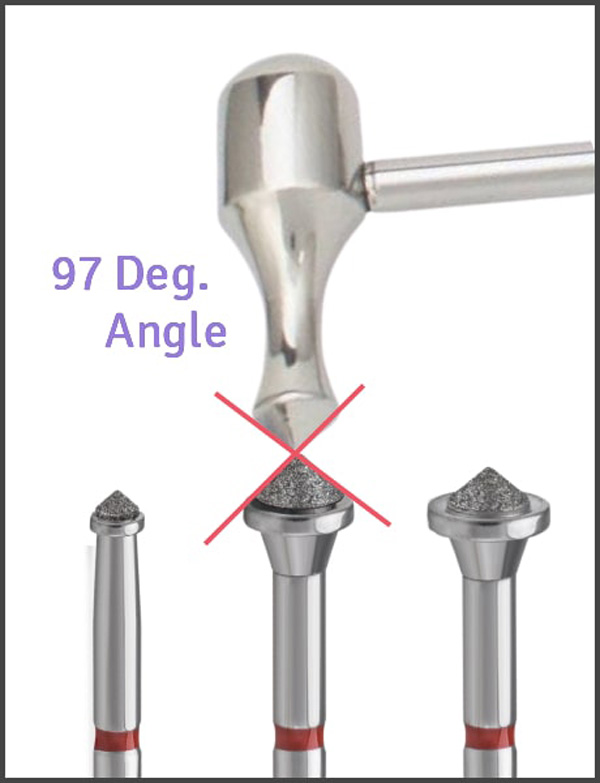 |
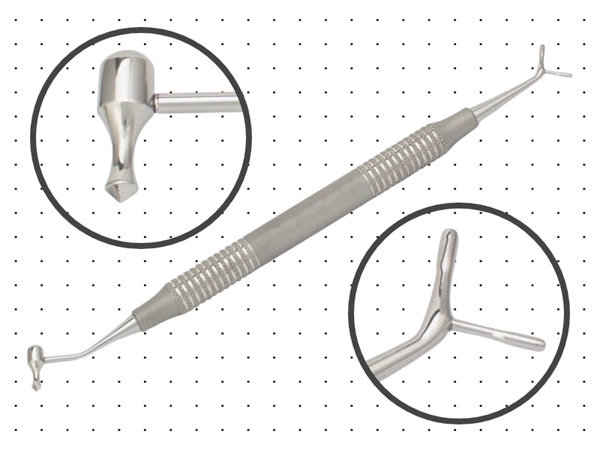 |
| Figure 1 The angulation of the acorn head of the Posterior Packer Sculptor (PPS) (Strauss Diamond) matches the angulation of the Acorn burs. | Figure 2 Four heads on the PPS eliminate instrument passing: Just flip the wrist to the next step. |
 |
 |
| Figure 3 The ball burnisher of the PPS promotes slight overfill: The acorn starts the pits and planes. | Figure 4 The acorn end pre-sculpts soft composite and light hardens the same, the acorn bur finishes sculpting, and the Xmas tree finishes and polishes the surface. |
The PPS has excellent ergonomics, with its generous diameter and non-slip surface yet weighing in at only 1 oz.
With a slight (10%) overfill and ball burnisher-smoothed margins, the instrument is flipped, and the acorn starts the basic planar anatomy: ie, pits and grooves are defined quickly. It is at this point (after composite curing) the Occlusinator Pro sculpting and finishing burs (Strauss Diamond) are utilized (Figures 3 and 4).
The Occlusinator PRO system comes with 3 different-diameter acorn-shaped diamonds and 2 Xmas tree-shaped diamonds that vary in grit pattern. The acorn-shaped burs are coated with 50-µm diamonds, and the Xmas trees have 15-µm diamonds (Figure 5).
The acorn burs have a safe edge/limit stop on the periphery of the bur head that prevents enamel nicking or scarring as well as carving too deep and are calibrated to leave the surface in occlusion.
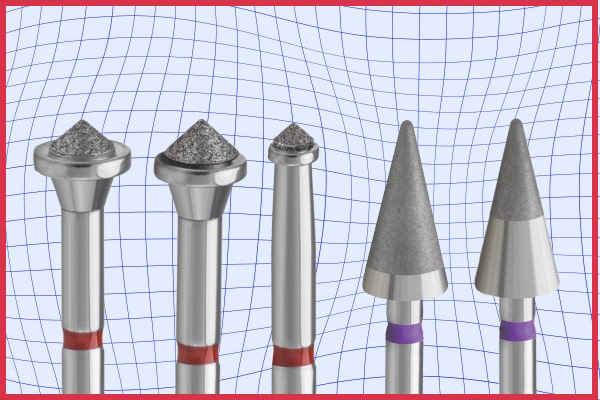 |
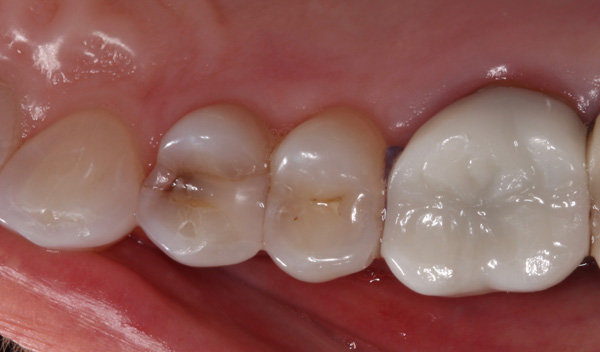 |
| Figure 5 The safe edges/limit stops on acorns and safe zones on Xmas trees eliminate scuffing of enamel as well as over-carving of the occlusion. | Figure 6 A failed restoration and marginal ridge fracture on a maxillary right first premolar. |
 |
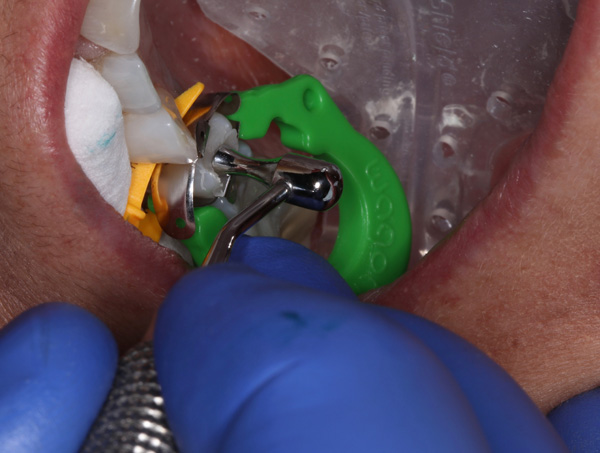 |
| Figure 7 Small and large Packer tips were utilized to direct bulk-fill composite into the preparation. The Premier X5 Sectional Matrix System (Premier Dental), ring is disposable. | Figure 8 After smoothing margins with the ball burnisher, the acorn forms the planes and pits. Isolite and cotton rolls provide a clean/dry area in anterior. |
The Xmas trees have 2 different-sized diamond zones that allow the diamond-free safe zone to engage the remaining enamel without nicking or scarring it. Traditional football diamonds or carbides will over-carve or concave the surface when making final adjustments by virtue of their convex shape. They also create “bur tracks” in the enamel if they come in contact with it.
The 3 safe-edged acorn burs and 2 Xmas tree burs are “prescriptive” in their use—all different sizes of occlusal restorations are accommodated safely. In addition, large and small Class V composites are addressed with the appropriate-size diamond zone on the Xmas trees. The diamond-free safe zone of the Xmas tree—running above the occlusal margin of the Class 5—will not nick or scar the enamel should it come in contact. Whether one is dealing with a large or small isthmus width, a fissurotomy, a box-only prep, or a large or small Class V, the Occlusinator PRO system meets the challenge.
 |
 |
| Figure 9 A small acorn with a safe edge finishes the planes and pits, leaving a smooth surface. | Figure 10 The Xmas tree with polishing grit defines the pits and planes. The safe zone protects the enamel and margins. |
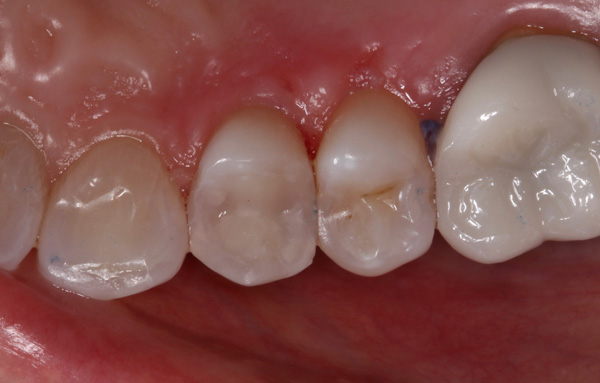 |
|
| Figure 11 The PPS instrument, acorn and Xmas tree burs create well-defined anatomy quickly–without requiring further polish. |
CASE REPORT
In a case done by Dr. Schmedding, a patient presented with a failed restoration needing replacement on the upper right first premolar (Figure 6). After cavity preparation and the application of appropriate bonding materials, a bulk-fill composite was injected into the proximal boxes. The small condenser utilized on the PPS instrument directed the composite toward the deepest part of the box forms (Figure 7). The composite was cured according to manufacturer’s instructions.
After the placement of composite in the main channel at a slight overfill (approximately 10%), the acorn burnisher on the PPS instrument helped to establish pits and fissures as well as cuspal inclines (Figure 8).
After light-curing, the small acorn bur created the initial steps of finishing the pits and fissures of the restoration (Figure 9). There are 2 larger sizes of acorn burs in the kit for larger restorations or wider isthmuses.
Once the anatomy was formed, the Xmas tree diamond bur was utilized to redefine the cuspal inclines safely without ditching the enamel-composite interface (Figure 10).
The finished restoration, with proper anatomical contours and definitions, is shown in Figure 11.F
ABOUT THE AUTHORS
Dr. Roetzer is a Fellow in the American and the International Colleges of Dentistry and a member of the Pierre Fauchard Society. He has served as professional relations director at Danville Materials/Zest Dental Solutions and consults with several other manufacturers. He currently serves as a full-time associate professor and co-director of the International Dental Student program at the University of the Pacific, Arthur A. Dugoni School of Dentistry, where he had served as the director of operative dentistry. He is a member of the Consortium of Operative Dentistry Educators and serves as a grader in the Western Regional Examination Board. Dr. Roetzer is an international lecturer and has developed and patented a number of dental devices. He can be reached at paddyraptor@gmail.com.
Dr. Schmedding graduated from the University of Puget Sound prior to getting his DDS degree at the University of the Pacific, Arthur A. Dugoni School of Dentistry. For 17 years, Dr. Schmedding practiced in Seattle prior to relocating to California. He held a position as an assistant professor in the Department of Integrated Reconstructive Dental Sciences at the University of the Pacific, Arthur A. Dugoni School of Dentistry. In addition to his pursuits in academia, Dr. Schmedding enjoys his private practice in Walnut Creek, Calif, and enjoys lecturing nationally and internationally on topics ranging from advanced dental materials and products to complex restorative procedures. He has published articles both nationally and internationally regarding dental restorative materials and procedures. Dr. Schmedding is a current member of the ADA, the California Dental Association, and the American Academy of Cosmetic Dentistry. He is one of 450 dentists worldwide to be an accredited member with the American Academy of Cosmetics. He can be reached at troy.schmedding.dds@gmail.com.
Disclosures: Dr. Roetzer designed and patented both the Occlusinator and the Posterior Packer Sculptor. Dr. Schmedding has no financial interest in any of the products mentioned in this article.



